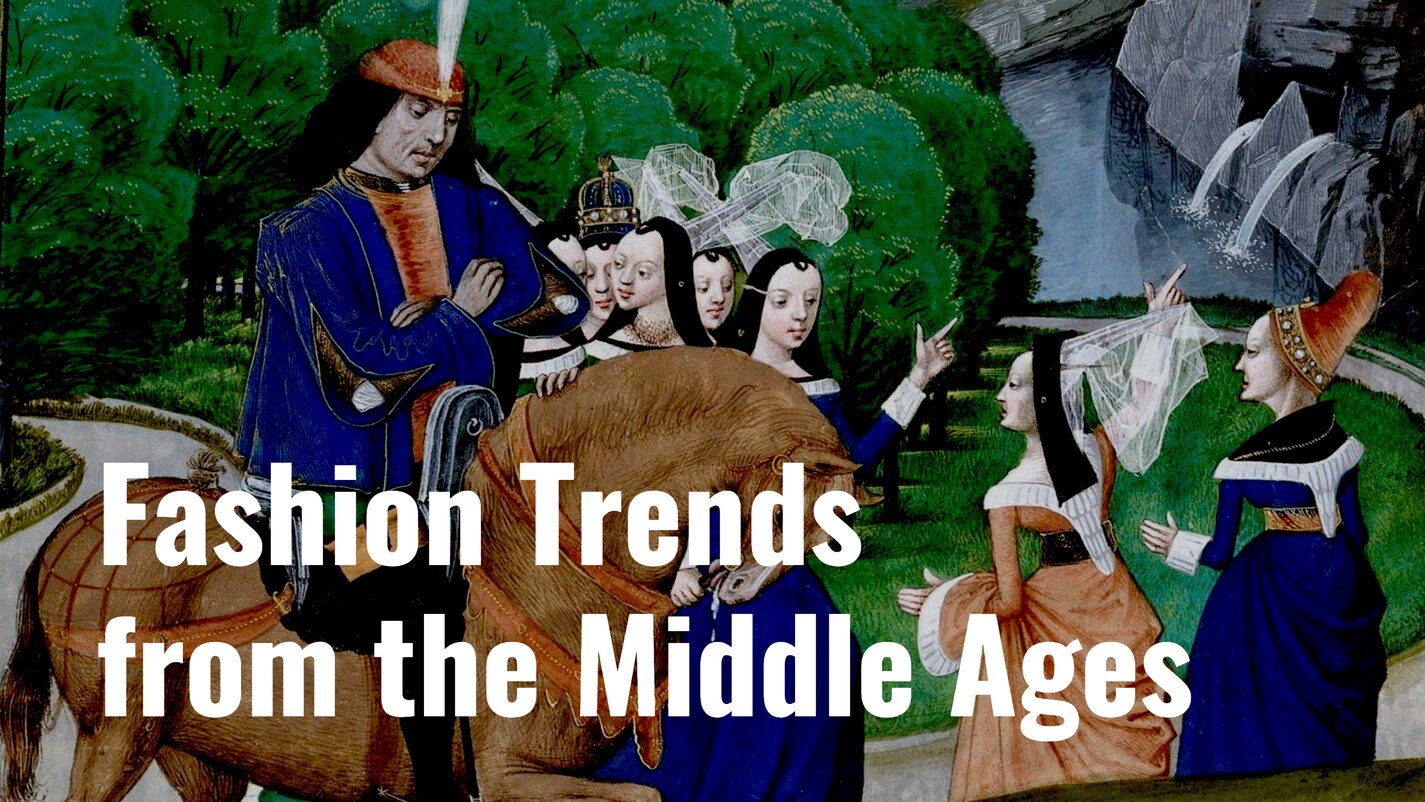Fashion in the Middle Ages was anything but static. It was a vibrant, evolving tapestry that reflected the era’s cultural shifts, political changes, and social hierarchies. Imagine a time when the length of a tunic or the embellishments on a cloak could signal one’s status, or when the choice of fabric could speak volumes about one’s wealth and influence.
This article takes you on a journey through the centuries, using vivid images from medieval manuscripts to track the dynamic trends of the time. From the opulent garments of Carolingian emperors to the practical yet elegant attire of Anglo-Saxon nobility, medieval fashion offers a fascinating glimpse into a world where clothing was more than just necessity—it was a statement. Join us as we explore the styles that defined an era, uncovering the stories woven into the very fabric of medieval life.
The Carolingian Elegance – Emulating Roman Grandeur
In this image of Carolingian Emperor Charles the Bald and his wife, made between 866 and 875, Charles is depicted in a sleeved tunic, a loose cloak, and long leg coverings. His outfit, typical of Carolingian fashion, is adorned with gold and jewels, emphasizing his status. The Carolingian rulers viewed themselves as heirs to the Roman Empire and sought to emulate Roman grandeur in their attire. His wife wears a long veil, two tunics, and jewelry, including earrings and a bracelet, further illustrating the influence of Roman fashion on Carolingian dress. This opulence was not just for show; it was a statement of power and continuity with the revered Roman past.
Anglo-Saxon Attire – Practical and Modest
An image from 966 shows English King Edgar (959-975) flanked by the Virgin Mary and St. Peter. Edgar is dressed in a knee-length tunic and cloak, with leather stockings extending from ankle to knee. The female figure wears a long, loose woolen gown, a mantle, and a head covering. Nearly all Anglo-Saxon women, except for the very young and slaves, wore head coverings, reflecting societal norms of modesty and propriety. These garments were designed for practicality, suitable for the English climate and the daily activities of the wearer.
Byzantine Opulence – Pearls and Purple
Originally a portrait of Byzantine Emperor Michael VII (1071-1078), later altered to depict his successor Nicephorus III (1078-1081), this image showcases Byzantine opulence. Nicephorus is clad in a blue tunic over a purplish-red one, adorned with pearls, which were highly valued among Byzantine elites. One predecessor’s outfit was so heavily decorated with 30,000 pearls that he couldn’t sit down while wearing it. Civil servants wear the chlamys, a red and gold garment. Byzantine fashion was heavily influenced by Asian imports, which in turn influenced Western Mediterranean styles. This cross-cultural exchange enriched the Byzantine wardrobe, making it one of the most luxurious in the medieval world.
Norman Nobility – The Bayeux Tapestry
The Bayeux Tapestry, an eleventh-century artifact, depicts William, Duke of Normandy, with his half-brothers Odo and Robert. This tapestry is a valuable source for understanding Norman fashion, showing William in elaborate hosiery and a gold-embroidered cloak. The detailed depiction of clothing offers subtle hints about the wearers’ status and personality, reflecting the significance of attire in medieval society. Clothing was not merely functional; it was a language of power, identity, and artistry.
Early 12th-Century Trends – Fashionable Knights
A manuscript image from the early 12th century depicts a knight standing on his squire while fighting a dragon, showcasing the period’s fashion trends. Long-toed shoes, popularized by Fulk, Count of Anjou, who used them to hide his bunions, became a widespread fashion statement. This trend, akin to modern sports-star-endorsed sneakers, illustrates the influence of high-status individuals on popular fashion.
Seasonal Wardrobes – Dressing for the Weather
A late-13th-century health book offers advice on appropriate clothing for different seasons. In spring, robes of cotton or fine woolen cloth are recommended to avoid extreme temperatures. Summer calls for cool clothing like linen or silk. Autumn attire should be slightly warmer than spring, while winter necessitates thick, fluffy wool and fur for warmth. These seasonal guidelines reflect a practical approach to medieval dress, balancing comfort and functionality.
Wealthy Italians – High Fashion in the 13th Century
The rise of city-states in High Medieval Italy brought significant wealth, influencing fashion. A late-13th-century image shows three well-dressed Genoese men, their clothing adorned with gold edges, fur, and oversized buttons. However, the image critiques their attire, symbolizing the sin of Pride, highlighting the moral and social implications of fashion.
14th-Century Women – Evolving Styles
An image from the first half of the 14th century depicts two women, showcasing evolving fashion trends. Only the married woman wears a veil, and their tunics have shorter sleeves, reaching only to the elbow. These changes reflect a shift in societal norms and the increasing influence of fashion on women’s appearance.
Royal Attire – Dressing a King
An image depicting preparations for Charles V of France’s coronation in 1364 shows the king in a red silk tunic with front laces. His chamberlain is putting on stockings decorated with fleurs-de-lys. Most men in the scene wear colorful long tunics. The elaborate attire underscores the importance of regal appearances in reinforcing authority and prestige.
Renaissance Italian Fashion – St. Ursula’s Influence
A depiction of St. Ursula and her virgin companions from the 1380s illustrates the changing fashion in early Renaissance Italy. The women wear tight-fitting tunics that expose their necks and parts of their shoulders. This shift towards more revealing clothing marks a departure from the more conservative medieval styles, reflecting broader cultural changes.
Sumptuary Laws – Regulating Dress
A scene shows men and women condemned by an abbot for their immodest appearance. In late medieval England and Italy, sumptuary laws regulated clothing, especially for non-nobles. These laws aimed to maintain social order but were often ineffective and widely ignored, reflecting ongoing tensions between societal norms and personal expression.
15th-Century Elegance – Noble Fashion
A 1470s image from northern Europe depicts noblemen and women in the latest fashion. The rider sports longer hair, a shorter cap, and gown, while the women wear steeple-shaped headdresses. One woman loops her gown’s long train around her hand, making it easier to walk. These details highlight the practical and aesthetic considerations in late medieval fashion.
The Return of Black – Medieval Colour Trends
Late medieval images reveal black clothing’s rising popularity. Previously unfashionable and associated with poverty, black became a fashionable color. Other colors held symbolic meanings: green for love, grey for sorrow, yellow for hostility, and blue, linked to the Virgin Mary, for fidelity. The Tres Riches Heures du Duc de Berry illustrates the colourful diversity of medieval fashiom
Royal Accessories – Jewelry of Kings
King Charles VIII of France (1483-1498) attempted to restrict gold and silver cloth to the wealthiest nobles. Like his Carolingian predecessors, he adorned himself with jewelry, including diamonds, rubies, and a gold medallion. These luxurious accessories underscored the king’s wealth and status, reinforcing the importance of appearance in medieval politics.
Fashion at the End of the Middle Ages – Blending Old and New
An image from the 1490s depicting a scene from the Roman de Rose blends older medieval styles with newer trends. Women wear gowns with wide sleeves, while men sport elaborate hose. This blend of styles indicates an awareness of fashion’s evolution, highlighting the dynamic nature of clothing at the end of the Middle Ages.
The journey through medieval fashion reveals more than just changing styles; it uncovers the intricate relationships between clothing, culture, and society. Each era, from the Carolingians to the late 15th century, demonstrates how fashion was influenced by and reflected broader historical trends, from political shifts to economic developments. Whether through the opulent attire of Byzantine emperors or the practical yet symbolic garments of Anglo-Saxon women, clothing served as a powerful tool for expressing identity, status, and values. As we look back on these trends, we can see the enduring impact of medieval fashion on modern clothing. The emphasis on detail, the use of luxurious materials, and the significance of fashion as a status symbol continue to resonate today. By studying the past, we gain a deeper appreciation for the ways in which fashion shapes and is shaped by the world around us. Medieval fashion was more than mere dress—it was a dynamic and expressive art form that offers us valuable insights into the lives and times of those who came before us.
Further Readings:
![]() The book, Medieval Dress and Fashion by Margaret Scott, offers a great resource about the changes in fashion during the Middle Ages. You can also learn more about medieval fashion from these articles:
The book, Medieval Dress and Fashion by Margaret Scott, offers a great resource about the changes in fashion during the Middle Ages. You can also learn more about medieval fashion from these articles:
Medieval Nuns knew their fashion, historian finds
Medieval lingerie? Discovery in Austria reveals what really was worn under those tunics
Viking Fashions were provocative, historian finds
Medieval Garments Reconstructed: Norse Clothing Patterns
Anglo-Saxon costume: a study of secular civilian clothing and jewellery fashions
Constructing the Headdresses of the Fourteenth and Fifteenth Centuries
Underwear in the Maciejowski Bible
Estreitement bende: Marie de France’s Guigemar and the erotics of tight dress
Illuminating Fashion: Dress in the Art of Medieval France and the Netherlands











